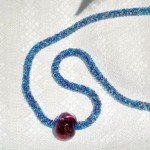
tubular seed beads with focal bead
There are many different styles for stringing beads into finished pieces. These are not for sale, but are examples of my work.
This one shows a focal lampworked bead with a choker made of seed beads, woven in peyote stitch into a tube. Mo approved. These will be fun to make in a rainbow of colors.
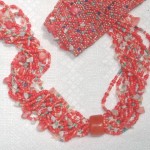
multicolored multistrand
…
On the left is a set of multicolored seed beads; coral, turquoise, deep blue, with chips of opal and chunks of coral interspersed. The multistrand necklace has a coral focal bead, and the peyote stitch bracelet has coral buttons. Click to see entire view.
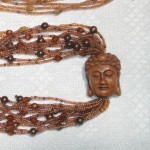
brown buddha
…
On the right, is a multistrand seed bead necklace in a gradient of browns, interspersed with brown pearls and larger brown faceted glass beads. Click to see the matching earrings. I did not carve the lovely boxwood Buddha bead, the signature on the back might be Japanese.
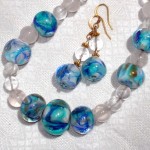
best of 2008 blues
…
Lastly, a single strand that has the best of the blue beads I made in 2008 during classes at Glass Expressions, in Burien, WA. The clear and frosty beads are quartz. Also shown are matching earrings.
Click on any of the photos for a larger view.
Tags: beads, bracelet, earrings, glass, gradient, handmade, necklace, peyote, seed, stitch, stringing
 AuraSunArts, private reserve, seed beads | mary |
AuraSunArts, private reserve, seed beads | mary |  June 27, 2010 2:13 pm |
June 27, 2010 2:13 pm |  Comments (0)
Comments (0)
The fawns are back for a return visit.
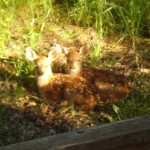
fawns settle down
Here they are resting in the afternoon sun, their mother just a few feet away, taking a load off those long legs herself.
One morning as she grazed, they sprinted among the pines on the hillside, zig-zagging in a game of chase, their white tails up like flags, the extra high leaps reminding me of pronking springbok.
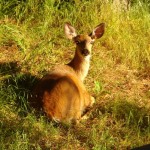
mom by their side
As they were resting here, one of the cats leaped up on the deck in the foreground, startling the little guys before I could get in any more shots.
Click for a larger view of these delightful visitors.
Creating small sculptures in glass is an interesting challenge.
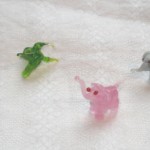
elephants and friends, click to see all
The molten glass is like taffy or honey and tends to leave strings of itself behind. You melt an initial blob to be the body, then dab on another blob at the hip, and watching carefully, pull slowly, drawing out a string of the proper thickness to form a leg, bending it into a leg shape, and then melt the excess away at the foot. Later as you are working on another leg, you must take care to not accidentally melt the first leg, or melt off the tail. It is wise to work on the biggest body parts first and leave the tiny extremities for the last.
Here are some of my baby steps in this arena; a black horse, a green hummingbird, and a trio of elephants. These are not for sale, they are just kindergarten doodles.
To see the work of master glass sculptor Pino Signoretto, and learn about his life, check out this in depth interview at the Nautica website.
“Furthermore, glass itself has something to do with the sea, in effect, to make the magic happen you need four ingredients: sand, water, air and fire, to which I would add a fifth element which is the physical energy which the artist needs to use to shape glass.” ~ Pino Signoretto
Tags: air, animal, element, fire, glass, molten, sand, sculpture, sea, water
 making glass beads, private reserve | mary |
making glass beads, private reserve | mary |  June 20, 2010 5:10 am |
June 20, 2010 5:10 am |  Comments (0)
Comments (0)
Hello Mo fans!
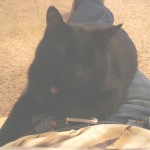
- king of the lap
Mr Mo is the undisputed king of the lap. You cat lovers know. You sit down somewhere and along comes a cat to claim that warm and cozy throne, and there you are stuck, pinned in place, unable to answer the phone.
He cracked me up a couple times by trying to find that lap while I was doing yoga. I couldn’t get a photo of that, but here’s a digital doodle that tells the story.
That’s my Mo.
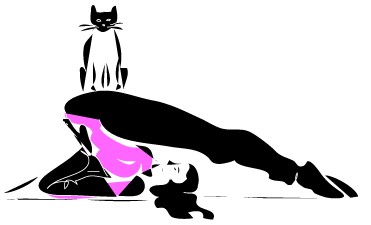
mo yoga helper
Having some copper wire on hand,
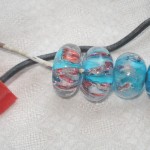
chunks of copper wire encased in glass
I thought to try incorporating some small chunks into some beads. Now if you are trying to melt copper, it is a cranky metal, and will just throw sparks as you pour on the heat with the torch, until it finally surrenders. It holds heat and conducts it, but doesn’t like to melt.
I expected the bits of copper wire to stick readily to the molten glass, but it was having none of it, only left a dent in the soft mass. Well, I flipped the bead dent side up and placed the chip of copper in the cavity with pliers and then sealed it in with clear glass encasing. Great fun! The bright copper looked fine against the turquoise glass. Turquoise and copper are mined together, a natural pair.
The molten glass behaved differently with the copper heat sink it contained, and I tried to let them cool extra slowly, but they still cracked. A grand experiment, nonetheless. Further trials with thinner gauge wire await. Click on the photo for an enlarged view.
Hello Mo fans!
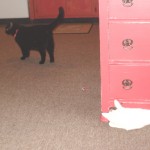
nims under the bureau
The cats have settled back to their normal routine of chasing each other around the house. One day Nims was hiding under a small braided rug while Mo circled around batting at the odd lump. I wasn’t fast enough to snap a shot of that but I caught the end of this episode of hide and seek. Nims used to hide under this bureau as a kitten and can just barely fit under there now.
She is eating well and seems completely recovered from her intestinal distress. I guess I will have to eat the rest of the liver, pumpkin, and prune juice. Hmm, what would the Top Chef Masters do with that challenge?
Blue has to be one of my favorite colors.
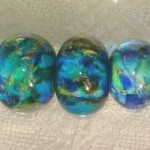
oceanic blues and greens
Blue glass beads can remind one of the fabulous colors of the ocean. Tropical waters are very clear, with little plankton, and the water is clear all the way down to the sandy bottom, showing off those gorgeous turquoise tints. Northern waters, with richer plankton, are a dark blue green.
When you paint with watercolors, you can combine or layer colors to blend and mix until you achieve new colors. Glass is much the same, so start with a sandy layer, then add pale blues and greens, deeper blues, some flotsam, jetsam, and a few bubbles, and you can almost imagine yourself snorkeling, rocking in the ocean to the sound of your breathing.
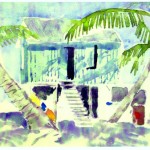
watercolor painted in Belize
Click on the photo to see more big blues. Those with a layer of clear glass on the outside – “encasing” – have an extra sense of depth. This layer refracts and bends light just as water does. Quite a few of these are matched pairs or sets. See all the blue beads on the Blue oceans page. Other new sets are featured on the Earrings page.
Tags: AuraSunArts, beads, blue, breathe, bubbles, color, depth, earrings, encasing, glass, gorgeous, ocean, paint, pair, refract, sand, turquoise, water, watercolors
 AuraSunArts, making glass beads | mary |
AuraSunArts, making glass beads | mary |  June 6, 2010 1:01 pm |
June 6, 2010 1:01 pm |  Comments (0)
Comments (0)
Hello Mo fans!
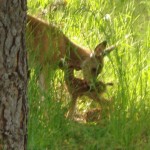
twin fawns with doe
The cats will take back seat this week to let their guests take the spotlight.
The back yard is forested and wild and we have sighted deer, raccoons, and wild turkey flocks passing through. This week we had the privilege of seeing a doe with her just – born twin fawns, teetering on their slender legs as she licked them dry.
This was worth taking a break from bead making to stop and watch. The cats noticed too and watched quietly from a respectful distance.
Click on the photo for a larger view of this tranquil scene.













